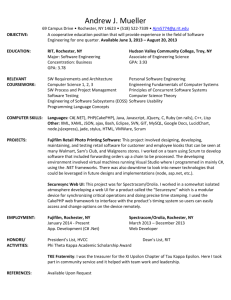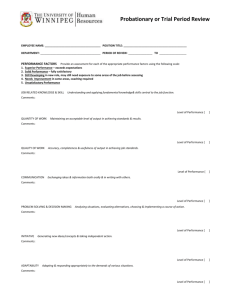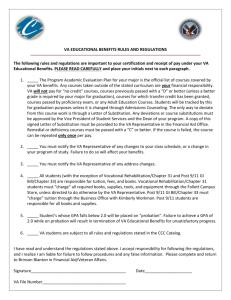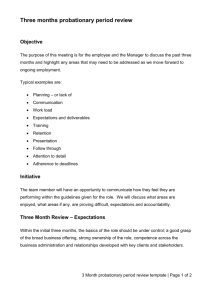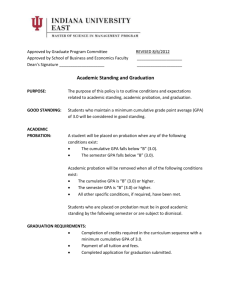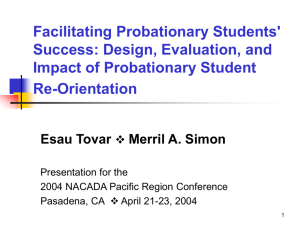Student Self Reflection: A Study of the Effect of Guided Self
advertisement
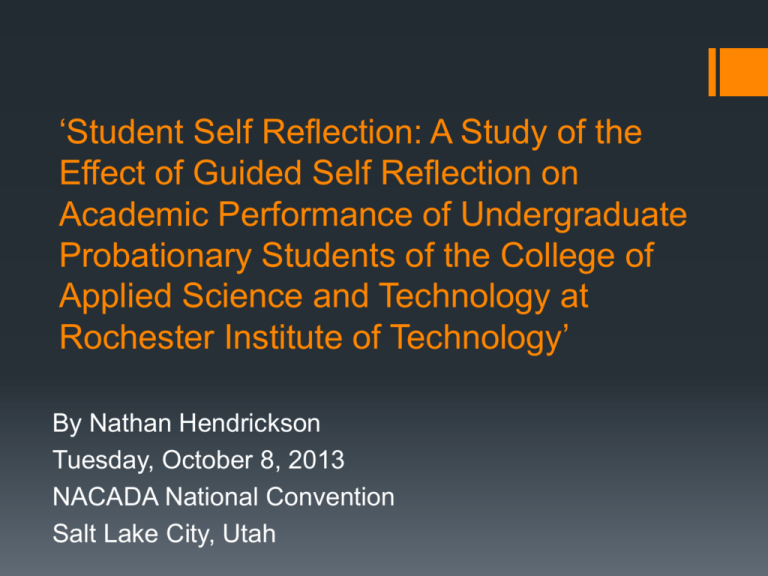
‘Student Self Reflection: A Study of the Effect of Guided Self Reflection on Academic Performance of Undergraduate Probationary Students of the College of Applied Science and Technology at Rochester Institute of Technology’ By Nathan Hendrickson Tuesday, October 8, 2013 NACADA National Convention Salt Lake City, Utah Alternate Title SSR: A Study of the effect of GSR on AP of UPS of CAST at RIT Agenda • • • • • • • • What is CAST? Question Background “Insights on Success” The Materials Selection Process The Results Discussion/Questions What is CAST? RIT enrollment 17,950 Students (2012) 9 Colleges College of Applied Science & Technology CAST enrollment 1,900 students (2012) Majors: Civil Engineering Technology, Computer Engineering Technology, Electrical Engineering Technology, Environmental Health & Safety, Hospitality, Mechanical /Electrical Mechanical Engineering Technology, Packaging Science Question What are your colleges or universities offering as programs for probationary students? Workshops (mandatory or nonmandatory) Meetings with their advisor Specific class on academic success or strategies Background What motivates me to want to work with academic probationary students? What does RIT offers to probationary students? Parameters Old Identified by adviser or Academic Support Center Encouraged Student Targeted Students ≤ 2.0 GPA 2.0 – 2.1 GPA New Same target for students Switched up the process Emailed Called Enrolled while meeting with student Enrollment increased The Class, “Insights on Success” 10 week course Students start off by taking the Learning And Study Strategies Inventory (LASSI), and identifying what has contributed to their probation status Students work through Time Management, Study Skills, and Study Strategies Students are required to meet with their instructor twice during the duration of the course “Coaching” The Materials Characteristics of Academic Success: 5 Star Student 4 Star Student 3 Star Student 2 Star Student 1 Star Student What would their room look like? How do they spend their time? Types of organization tools used to stay on track What motivates this student? How would this student cope with a challenge or set back? Insights Timeline Week 1/Week 8 • LASSI • Confidence Building Week 6 • Test Taking • Test Prep and test taking Week 2 • Self Test & Study Aids • Journaling throughout Coaching Coaching Week 3 • Motivation • Procrastination Week 5 • Attitudes • Interests, abilities Week 4 • Selecting Main Ideas • Textbook marking/ Notes Group Breakdown Insights Class Group = 30 Seniors = 3 Juniors = 5 Sophomores = 11 Freshman = 11 Control Group = 33 Students Seniors = 17 Juniors = 7 Sophomores = 4 Freshman = 5 The Results Quarterly GPA The Results Cumulative GPA Conclusion/Future Research 1 of the students in the Class left 6 of the students in the Control Group left Freshman motivation/maturity Questions Contact Information: Nathan Hendrickson Academic Advisor Rochester Institute of Technology Civil Engineering Technology/Environmental Health & Safety, Electrical, Computer, Telecommunications Engineering Technology NJHIAO@rit.edu (585) 475-3186 References Arco-Tirado, J., Fernandez-Martin, F., Fernandez-Balboa, J.M., (2011). “The impact of a peer-tutoring program on quality standards in higher education”. Higher Educ. Springer Science+Business Media. Balduf, M., (2009). “Underachievement among college students”. Journal of Advanced Academics, 20(2), 274-294. Cruise, C. (2009). “Advising students on academic probation”. The Mentor, www.psu.edu/dus/mentor/021028cc.htm retrieved on January 13, 2013. Engstrom, C., & Tinto, V., (2008). “Access without support is not opportunity” retrieved from http://soe.syr.edu/media/documents/faculty/TINTO_VITA.pdf., January 20, 2013. Kamphoff, C., Hutson, B., Amundsen, S., & Atwood, J., (2007). A motivational/empowerment model applied to students on academic probation. Journal of College Student Retention, Vol. 8(4), 397-412. Kirk-Kuwaye, M. & Nishida, D. (2001). Effect of low and high advisor involvement on the academic performances of probation students. NACADA Journal, 21, 40-45. Rochester Institute of Technology, Student Information System, retrieved June 12, 2013.
